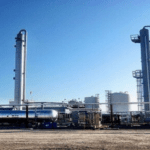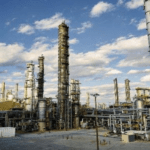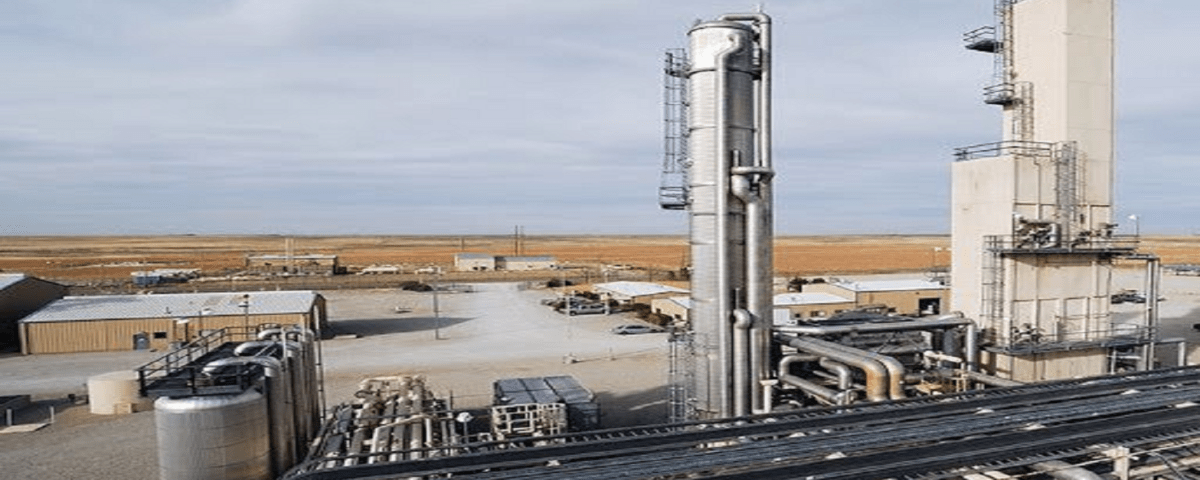
Gas Sweetening Unit
مهر ۵, ۱۴۰۳
Gas Condensate Stabilization Unit
مهر ۵, ۱۴۰۳MEG Regeneration Unit
In the process of fluid transfer from offshore wells to the 32-inch pipelines, due to the multiphase nature of the flow, there is a risk of hydrate formation, which could block the path. To prevent this issue, a 70% by weight MEG and water solution is injected into the pipelines. After injection, due to the presence of water in the fluids received from the wells, the concentration of MEG decreases. This solution, which also contains some hydrocarbon liquids and sulfur compounds, is referred to as Rich MEG.
The Rich MEG solution is first separated from the gas condensates in Unit 103 and then sent to Unit 102. Before entering the MEG regeneration package, it passes through a Preflash Drum, which functions as a three-phase separator. Subsequently, it is filtered through an Electrostatic Coalescer and joins the flow exiting the desalter.
MEG Regeneration Process
In the initial years, the incoming solution to Unit 102 is expected to have a concentration of approximately 38% MEG. The primary function of Unit 102 is to regenerate the Rich MEG and convert it into Lean MEG with a concentration of 70%. This unit includes two storage tanks for Rich MEG and two tanks for Lean MEG, each with an approximate volume of 1000 cubic meters. Furthermore, to prevent corrosion in the gas transmission pipelines, a 50% MDEA amine solution is used to control the pH.
Corrosion and pH Control
When glycol oxidizes or decomposes (due to excessive heat), it becomes acidic. Therefore, the pH must be controlled to ensure the MEG solution injected into the 32-inch pipeline does not cause corrosion. The MDEA storage tank has a capacity of about 28,000 cubic meters, and the MDEA solution is fed into the MEG injection pumps via a reciprocating pump with adjustable stroke to maintain the correct pH.
Lean MEG Injection and Supporting Equipment
For Lean MEG injection into the offshore facilities, three reciprocating pumps are utilized. Typically, two pumps are operational for injecting into two 32-inch pipelines, and one pump is kept on standby. To boost the inlet pressure of these pumps, two booster pumps are provided, of which one is usually in service. Between the booster pumps and the MEG injection pumps, there are two filters, one of which is normally active.
Rich MEG Regeneration
In this process, four glycol regeneration packages are available, with three typically in operation and one on standby. The incoming Rich MEG is divided among these packages. In abnormal conditions, when inlet pressure is high, the excess Rich MEG is diverted to the Flash Drum via PV valves on the inlet and then sent to the Rich MEG tanks under controlled conditions.
Glycol Regeneration Packages
The Rich MEG solution first enters the Flash Drum, where its pressure is maintained at approximately 4 bar using nitrogen. In this drum, hydrocarbon liquids are separated and sent to the Off-Spec tank. The MEG in the drum, under nitrogen pressure, is sent to the Reboiler through two cartridge filters, where it is heated to approximately 127°C by low-pressure steam. The Lean MEG exiting the Reboiler passes through a heat exchanger, which preheats the incoming Rich MEG, before being sent to the storage tanks.
Steam Control and Water Removal
The water in the Rich MEG evaporates due to the heat from the steam and, after passing through air coolers, condenses into a liquid containing acidic substances. Most of this liquid is then sent to Unit 109 (Sour Water Stripper), while the remaining portion is used as reflux. It is important to note that the Lean MEG produced must be dried through air coolers before entering the storage tanks.

